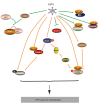DNA damage response is hijacked by human papillomaviruses to complete their life cycle
- PMID: 28271657
- PMCID: PMC5369246
- DOI: 10.1631/jzus.B1600306
DNA damage response is hijacked by human papillomaviruses to complete their life cycle
Abstract
The DNA damage response (DDR) is activated when DNA is altered by intrinsic or extrinsic agents. This pathway is a complex signaling network and plays important roles in genome stability, tumor transformation, and cell cycle regulation. Human papillomaviruses (HPVs) are the main etiological agents of cervical cancer. Cervical cancer ranks as the fourth most common cancer among women and the second most frequent cause of cancer-related death worldwide. Over 200 types of HPVs have been identified and about one third of these infect the genital tract. The HPV life cycle is associated with epithelial differentiation. Recent studies have shown that HPVs deregulate the DDR to achieve a productive life cycle. In this review, I summarize current findings about how HPVs mediate the ataxia-telangiectasia mutated kinase (ATM) and the ATM-and RAD3-related kinase (ATR) DDRs, and focus on the roles that ATM and ATR signalings play in HPV viral replication. In addition, I demonstrate that the signal transducer and activator of transcription-5 (STAT)-5, an important immune regulator, can promote ATM and ATR activations through different mechanisms. These findings may provide novel opportunities for development of new therapeutic targets for HPV-related cancers.
Keywords: ATM/CHK2; ATR/CHK1; Amplification; DNA damage; Differentiation; Papillomavirus; STAT-5.
Conflict of interest statement
This article does not contain any studies with human or animal subjects performed by the author.
Figures



Similar articles
-
Topoisomerase IIβ-binding protein 1 activates expression of E2F1 and p73 in HPV-positive cells for genome amplification upon epithelial differentiation.Oncogene. 2019 Apr;38(17):3274-3287. doi: 10.1038/s41388-018-0633-1. Epub 2019 Jan 10. Oncogene. 2019. PMID: 30631149 Free PMC article.
-
STAT-5 Regulates Transcription of the Topoisomerase IIβ-Binding Protein 1 (TopBP1) Gene To Activate the ATR Pathway and Promote Human Papillomavirus Replication.mBio. 2015 Dec 22;6(6):e02006-15. doi: 10.1128/mBio.02006-15. mBio. 2015. PMID: 26695634 Free PMC article.
-
Modulation of the DNA damage response during the life cycle of human papillomaviruses.Virus Res. 2017 Mar 2;231:41-49. doi: 10.1016/j.virusres.2016.11.006. Epub 2016 Nov 9. Virus Res. 2017. PMID: 27836727 Free PMC article. Review.
-
FANCD2 Binds Human Papillomavirus Genomes and Associates with a Distinct Set of DNA Repair Proteins to Regulate Viral Replication.mBio. 2017 Feb 14;8(1):e02340-16. doi: 10.1128/mBio.02340-16. mBio. 2017. PMID: 28196964 Free PMC article.
-
Why Human Papillomaviruses Activate the DNA Damage Response (DDR) and How Cellular and Viral Replication Persists in the Presence of DDR Signaling.Viruses. 2017 Sep 21;9(10):268. doi: 10.3390/v9100268. Viruses. 2017. PMID: 28934154 Free PMC article. Review.
Cited by
-
The DNA damage response activates HPV16 late gene expression at the level of RNA processing.Nucleic Acids Res. 2018 Jun 1;46(10):5029-5049. doi: 10.1093/nar/gky227. Nucleic Acids Res. 2018. PMID: 29596642 Free PMC article.
-
The Role of Ataxia Telangiectasia Mutant and Rad3-Related DNA Damage Response in Pathogenesis of Human Papillomavirus.Pathogens. 2020 Jun 23;9(6):506. doi: 10.3390/pathogens9060506. Pathogens. 2020. PMID: 32585979 Free PMC article. Review.
-
Research progress on the role and mechanism of DNA damage repair in germ cell development.Front Endocrinol (Lausanne). 2023 Jul 17;14:1234280. doi: 10.3389/fendo.2023.1234280. eCollection 2023. Front Endocrinol (Lausanne). 2023. PMID: 37529603 Free PMC article.
-
Pathogenesis of Human Papillomaviruses Requires the ATR/p62 Autophagy-Related Pathway.mBio. 2020 Aug 12;11(4):e01628-20. doi: 10.1128/mBio.01628-20. mBio. 2020. PMID: 32788179 Free PMC article.
-
Topoisomerase IIβ-binding protein 1 activates expression of E2F1 and p73 in HPV-positive cells for genome amplification upon epithelial differentiation.Oncogene. 2019 Apr;38(17):3274-3287. doi: 10.1038/s41388-018-0633-1. Epub 2019 Jan 10. Oncogene. 2019. PMID: 30631149 Free PMC article.
References
-
- Abbas AK, Lichtman AH, Pillai S. Cellular and Molecular Immunology. Philadelphia, PA: Elsevier Saunders; 2014.
-
- Aguilar-Quesada R, Munoz-Gamez JA, Martin-Oliva D, et al. Interaction between ATM and PARP-1 in response to DNA damage and sensitization of ATM deficient cells through PARP inhibition. BMC Mol Biol. 2007;8:29. (Available from: http://dx.doi.org/10.1186/1471-2199-8-29) - DOI - PMC - PubMed
-
- Ai W, Narahari J, Roman A. Yin yang 1 negatively regulates the differentiation-specific E1 promoter of human papillomavirus type 6. J Virol. 2000;74(11):5198–5205. (Available from: http://dx.doi.org/10.1128/JVI.74.11.5198-5205.2000) - DOI - PMC - PubMed
-
- Ali A, Zhang J, Bao S, et al. Requirement of protein phosphatase 5 in DNA-damage-induced ATM activation. Genes Dev. 2004;18(3):249–254. (Available from: http://dx.doi.org/10.1101/gad.1176004) - DOI - PMC - PubMed
-
- Anacker DC, Gautam D, Gillespie KA, et al. Productive replication of human papillomavirus 31 requires DNA repair factor NBS1. J Virol. 2014;88(15):8528–8544. (Available from: http://dx.doi.org/10.1128/JVI.00517-14) - DOI - PMC - PubMed
Publication types
MeSH terms
Substances
LinkOut - more resources
Full Text Sources
Other Literature Sources
Research Materials
Miscellaneous

